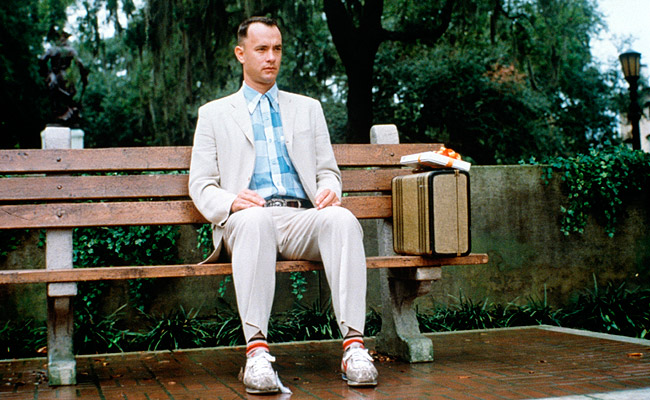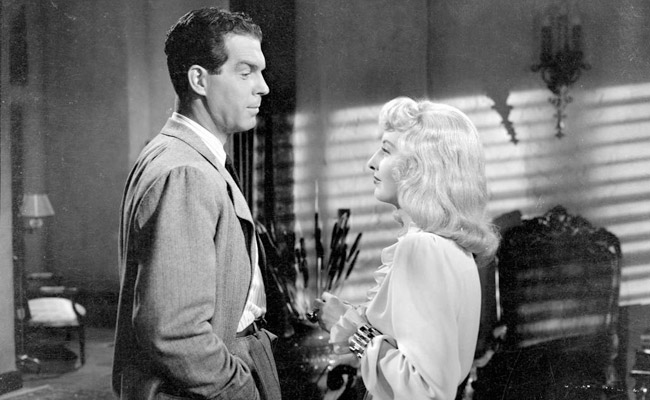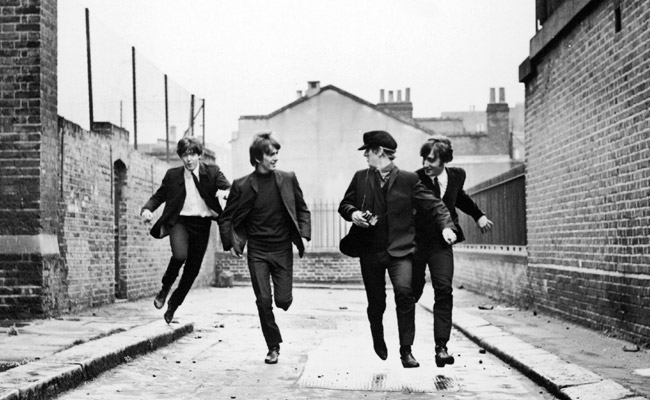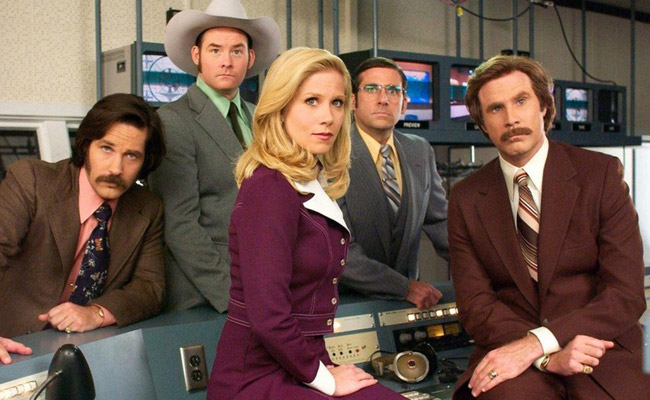
The Steve Tisch Company
It’s the Fourth of July week in the US and there are no shortage of new movies making their premieres. Except for 1984 which took the week off (the big movies were released the day before the holiday). One of the week’s bigger movies debuted in 1944, a film noir thriller that has gone on to become a bona fide classic. 1964 brought the British Invasion to the big screen, 1994 had an Oscar winner that broke new ground in the field of special effects, 2004 produced a comedy that has become a cult classic, and 2014 saw the end of a series of dance movies. Scroll down to see the list of films that premiered this week, and tell us if any of your favorites are celebrating milestone anniversaries!
1924
- July 6 – Captain January (USA, Sol Lesser Productions)
- July 6 – Code of the Wilderness (USA, Vitagraph Company of America)
- July 6 – The Heart Buster (USA, Fox Film Corporation)
- July 7 – A Woman Who Sinned (USA, Robertson-Cole Pictures Corporation)
- July 7 – Young Ideas (USA, Universal Pictures)
Captain January, starring Baby Peggy, was the first screen adaptation of the 1890 children’s book Captain January by Laura E. Richards. The book was adapted again in 1936 with Shirley Temple as the star. The film is only one of six Baby Peggy films to survive today with copies in archives around the world and in the Library of Congress.
A print of Code of the Wilderness is preserved in France at Archives Du Film Du CNC (Bois D’Arcy archive). The Heart Buster is a lost film. Young Ideas features an uncredited performance from future star Janet Gaynor. A print is held at the EYE Film Institute Netherlands.
1934
- July 6 – Charlie Chan’s Courage (USA, Fox Film Corporation)
- July 6 – Let’s Try Again (USA, RKO Radio Pictures)
- July 7 – Return of the Terror (USA, First National Pictures)
- July 7 – The Man They Could Not Hang (AUS, Invicta Productions)
- July 7 – The Personality Kid (USA, Warner Bros. Pictures)
- July 10 – Call It Luck (USA, Fox Film Corporation)
The Man They Could Not Hang opened in the UK on April 20, 1936 but has no known US theatrical release date.
Charlie Chan’s Courage marks the fifth appearance by Warner Oland as Chan. The film is a remake of 1927’s The Chinese Parrot and based upon the novel by Earl Derr Biggers. Both films are lost.
Let’s Try Again is known in the UK as Marriage Symphony.
Return of the Terror is not a sequel to but a loose remake of 1928’s The Terror based on Edgar Wallace’s play of the same name, shifting the setting from England to America. A 35mm print is preserved in the Library of Congress, and a 16mm print survives at the Wisconsin Center for Film and Theater Research. 16mm prints were used for television broadcast.
The Man They Could Not Hang is based on the life of John Babbacombe Lee, and was filmed previously in 1912 and 1921. Cast member Arthur W. Sterry exhibited the 1912 film and directed the 1921 film.
The working title for The Personality Kid was One-Man Woman.
1944

Paramount Pictures
- July 4 – A Fig Leaf for Eve (USA, Carry-Westen Productions)
- July 4 – The Story of Dr. Wassell (USA, Paramount Pictures)
- July 6 – Double Indemnity (USA, Paramount Pictures)
- July 7 – Trigger Trail (USA, Universal Pictures)
- July 8 – Johnny Doesn’t Live Here Anymore (USA, King Brothers Productions)
- July 8 – Movie Pests (USA, short, Metro-Goldwyn-Mayer)
- July 10 – The Fighting Seabees (UK, Republic Pictures)
- July 10 – The Way Ahead (UK, Two Cities Films)
The Fighting Seabees originally opened in the US on January 27, 1944. The Way Ahead opened in the US on June 3, 1945.
A Fig Leaf for Eve is also known as Desirable Lady, Flaming Girls, Hollywood Nights, Not Enough Clothes, Reckless Youth, Room for Love, and Strips and Blondes as American reissue titles.
The Story of Dr. Wassell was based on a book of the same name by novelist and screenwriter James Hilton. The film earned an Oscar nomination for Best Effects.
Double Indemnity was based on James M. Cain’s novella of the same name, which ran as an eight-part serial in Liberty magazine. Raymond Chandler was hired to write the screenplay after Charles Brackett quit due to the sordid material, which also made it difficult to adapt the story due to restrictions imposed by the Hays Code. Chandler did not get along with director Billy Wilder, but he did agree to appear in the film glancing up from a magazine as Walter Neff walks outside Keyes’ office. It is the only professional footage of the writer. Cain felt the screenplay was the only one made from his books that included material he’d wished he thought of. Barbara Stanwyck was hesitant to take the role of a killer after a string of heroines, but Wilder encouraged her to go for it. She was the highest paid actress in Hollywood at the time. Since the character of Walter Neff is weak and easily controlled, top actors like Alan Ladd, James Cagney, Spencer Tracy, Gregory Peck and Frederic March turned it down. George Raft turned it down because Neff wasn’t a cop. Fred MacMurray, the highest paid actor in Hollywood at the time, usually played happy-go-lucky good guys, and he told Wilder he was making a huge mistake by wanting to cast him feeling he didn’t have the skill for a more serious role. Wilder wore MacMurray down until he accepted. MacMurray believed Paramount, which had carefully cultivated him image, would never let him take the role but the studio did … as punishment to teach him a lesson for his next contract negotiation. His success in the role came as a surprise to them all. Edward G. Robinson wasn’t thrilled to take a third billed role, but he was paid the same as the leads which soothed his ego. The design of Walter Neff’s office was an inside joke, copying the corporate headquarters of Paramount Pictures in New York City. Stanwyck wears a blonde wig in the film, which many thought looked fake. Wilder insisted it was meant to represent her character’s phoniness. A week into filming, Wilder realized his mistake but there was too much footage already filmed to make any changes. Wilder brought the film in under budget at $927,262, even with $370,000 salary for four actors. The film received seven Oscar nominations for Best Picture, Director, Actress, Screenplay, Black-and-White Cinematography, Music Scoring and Sound Recording, but went home empty-handed. Wilder expected the film to win, but Paramount was pushing Going My Way. When that film’s director won, Wilder tripped him on the way to accept his award. The film was selected for preservation in the National Film Registry in 1992.
Johnny Doesn’t Live Here Anymore was the final film for director Joe May. A pre-stardom Robert Mitchum appears in a small role in the last 20 minutes of the film, although the film has been marketed to emphasize his appearance. Horror star Rondo Hatton gets a laugh in a brief cameo as an undertaker. Billy Laughlin, aka ‘Froggy’ in the Our Gang shorts, makes his only non-Our Gang appearance and speaks in his natural voice for the only time on film.
The Fighting Seabees was made in cooperation with the US Navy and the US Marine Corps. The Iverson Movie Ranch, well used for a string of Westerns, was transformed into the Pacific Islands with palm trees that were brought onto the set. The film received an Oscar nomination for Best Scoring.
The Way Ahead is also known as Immortal Battalion. Peter Ustinov co-wrote the screenplay. Ustinov also appears in one of his earliest roles. David Niven served as the film’s driving force and executive producer. The film ends with the words ‘The Beginning’ in an effort to galvanise public support for the final push in the war effort.
1954
- July 5 – Burnt Evidence (UK, Monarch Film Corporation)
- July 9 – Apache (USA, Hecht-Lancaster Productions)
- July 9 – Garden of Evil (USA, 20th Century Fox)
Burnt Evidence has no known US theatrical release date.
Apache was based on the novel Broncho Apache by Paul Wellman, which was published in 1936. The film was director Robert Aldrich’s first in color. Burt Lancaster and Jean Peters appear in brownface in the film.
Garden of Evil was filmed in CinemaScope. It was the first outdoor picture filmed using the process. Rita Morena appears at the beginning of the film as a Mexican cantina singer/dancer. The film’s working title, Volcano, was changed because an Italian film of the same name was playing in art houses at the time.
1964

Proscenium Films
- July 7 – A Hard Day’s Night (UK, Proscenium Films)
- July 7 – Séance on a Wet Afternoon (UK, Beaver Films)
- July 7 – The Killers (USA, Revue Studios)
- July 8 – The Moon-Spinners (USA, Walt Disney Productions)
- July 10 – Victim Five (West Germany, Towers of London Productions)
A Hard Day’s Night opened in the US on August 11, 1964. Séance on a Wet Afternoon opened in the US on November 5, 1964. Victim Five opened in the US on May 19, 1965 as Code 7, Victim 5.
A Hard Day’s Night is credited as the inspiration for The Monkees TV series and pop music videos, as well as other low-budget musical films with British pop groups such as Ferry Cross the Mersey with Gerry and the Pacemakers, and Catch Us If You Can with The Dave Clark Five. The film’s working titles were The Beatles and Beatlemania, but the group’s name is never mentioned. United Artists wasn’t all that interested in the film itself, but in the opportunity to release the film’s soundtrack before the group’s American record label Capitol Records could. They felt whatever they lost on the film would be made up by the sales of the album. The film was shot in near sequential order. UA asked director Richard Lester to dub the Beatles’ voices with Mid-Atlantic accents for the US release. The film was nominated for two Oscars including Best Original Screenplay.
The female lead role in Séance on a Wet Afternoon was initially turned down by Deborah Kerr and Simone Signoret. American actress Kim Stanley was offered the role despite her limited film work including the 1958 feature The Goddess and providing the opening and closing narration for To Kill a Mockingbird. Stanley received a Best Actress Oscar nomination for her work.
The Killers is known as Ernest Hemingway’s The Killers in the UK. It is the second film adaptation of Hemingway’s short story of the same name following a 1946 version. Ronald Reagan makes his final acting appearance in the film. It was his only villainous role, and he later said he regretted making the film. The film was intended to be part of the Project 120 series of made-for-TV movies, which never reached the airwaves. The working title was Johnny North. The film was considered too violent for television and received a theatrical release instead. After John Cassavetes was cast as a race car driver, director Don Siegel learned Cassavetes could not drive. The main title and closing credits music was originally composed by Henry Mancini for Touch of Evil, drawn from the Universal music library and re-edited for the film.
The Moon-Spinners was loosely based upon a 1962 suspense novel by Mary Stewart. The film features silent screen legend Pola Negri in her last screen performance. It was Hayley Mills’ fifth of six films for Disney. It also includes her first proper on-screen romance. This was the next to last film credited to Walt Disney as a producer while he was alive. Disney himself persuaded Negri to return to the screen after 20 years of retirement.
Victim Five was filmed in Cape Town, South Africa in Technicolor and Techniscope by cinematographer Nicolas Roeg.
1974
- July 6 – Vampyres (UK, limited, Essay Films)
- July 8 – Down and Dirty Duck (USA, Murakami-Wolf)
- July 10 – Oliver Twist (USA, Filmation)
Vampyres was released in the US in January 1975. The film featured Playboy’s ‘Girls of Munich’ model Anulka in her acting debut. The film has been distributed under various titles including The Vampyres, Blood Hunger, Daughters of Dracula, Satan’s Daughters, Vampyres: Daughters of Dracula and Vampyres: Daughters of Darkness. A remake was released in 2015.
Down and Dirty Duck was originally titled Cheap! and promoted under the shorter title Dirty Duck. It was the first animated film to feature LGBTQ characters. Roger Corman asked that the film’s title be changed because he didn’t want to release a film titled Roger Corman’s Cheap!, even though Corman is not credited as a producer on the film. The film was promoted as an X-rated animated film, but New World Pictures never submitted the film to the MPAA for a rating. The film has nothing to do with the Dirty Duck character which appeared in National Lampoon and Playboy magazines.
Oliver Twist is based on Charles Dickens’ 1838 novel of the same name. Former Monkee Davy Jones voices the role of the Artful Dodger, which he also played in the Broadway production of Oliver!
1984
- No new films were released this week in 1984.
1994
- July 6 – Forrest Gump (USA, The Steve Tisch Company)
- July 6 – That’s Entertainment! III (USA, Metro-Goldwyn-Mayer)
- July 8 – Pentathlon (USA, PFG Entertainment)
- July 8 – Staggered (UK, Big Deal Pictures)
Pentathlon originally opened in South Korea on June 4, 1994. Staggered opened in the US on November 19, 1994.
Forrest Gump is an adaptation of the 1986 novel of the same name by Winston Groom, focusing on the first eleven chapters before skipping to the end, adding aspects of Gump’s life that did not occur in the novel such as his leg braces. The book was the subject of a bidding war before it was published. It was the second highest grossing film of 1994 behind The Lion King. The film was selected for preservation in the National Film Registry in 2011. Warner Bros. was originally involved but lost interest after the release of Rain Man. The project went into turnaround in 1990. Columbia Pictures was approached but rejected the project. Paramount’s Sherry Lansing liked the script and brought the project to Paramount in 1992, exchanging it with Warner Bros. for the rights to Executive Decision. Ivan Reitman, Penny Marshall and Terry Gilliam were approached to direct but all passed before Robert Zemeckis was hired. John Travolta was the original choice for Forrest but turned it down, later saying that decision was a mistake. Bill Murray, Chevy Chase and Matthew Broderick were also considered. Tom Hanks signed on after reading the script for 90 minutes. Winston Groom had envisioned John Goodman for the role. Joe Pesci was considered for the role of Lieutenant Dan before Gary Sinise was cast. David Alan Grier, Ice Cube and Dave Chappelle turned down the role of Benjamin Buford Blue. Chappelle felt the film would not be successful, and later regretted not taking the role. Tupac Shakur also auditioned, but the role went to Mykelti Williamson. While set in Alabama, the majority of the film was shot in South Carolina. Hanks was integrated into archival footage through the use of blue screen, chroma key, image warping, morphing, and rotoscoping. Gary Sinise’s legs had to be painted out from every frame of film. The crowd scene at the Lincoln Memorial Reflecting Pool took two days to film using 1,500 extras rearranged and moved into different quadrants, and then multiplied with CGI to create a crowd of several hundred thousands. The film earned 13 Oscar nominations, winning six: Best Picture, Actor, Director, Visual Effects, Adapted Screenplay and Film Editing. It was also nominated for seven Golden Globes, winning three for Best Picture – Drama, Actor – Drama and Director.
That’s Entertainment! III was produced to celebrate the 70th anniversary of Metro-Goldwyn-Mayer. Unlike the first two films, this one focuses on outtakes, unfinished numbers and behind-the-scenes looks at classic musicals. Gene Kelly makes his last film appearance as a host. Other hosts were June Allyson, Cyd Charisse, Lena Horne, Howard Keel, Ann Miller, Debbie Reynolds, Mickey Rooney and Esther Williams, making her first film appearance in more than 30 years.
Pentathlon is the last film directed by Bruce Malmuth before his death in 2005. Staggered was the directorial debut of actor Martin Clunes.
2004

Apatow Productions
- July 7 – King Arthur (USA, Touchstone Pictures)
- July 9 – Anchorman: The Legend of Ron Burgundy (USA, Apatow Productions)
- July 9 – Pinocchio 3000 (Spain, Anima Kids)
- July 9 – Sleepover (USA, Metro-Goldwyn-Mayer)
Pinocchio 3000 opened in the US on July 13, 2005.
King Arthur reinterprets the Arthur characters as a Roman officer rather than a typical medieval knight. It also gives a darker and more tragic story as to how Arthur came into possession of his sword Excalibur. A replica of Hadrian’s Wall was the largest film set ever built in Ireland at the time.
Anchorman: The Legend of Ron Burgundy was the directorial debut of Adam McKay. An early version of the script featured Ron Burgundy and a group of news people stranded in the wilderness, trying to make their way back to civilization and included a musical number with sharks. Footage of San Diego seen in aerial shots include buildings that were not built or opened in the 1970s. The original version of the film focuses on the reporters tracking down a group of hippie bank robbers known as The Alarm Clock. After poor test screenings, significant portions of the film were re-written and re-filmed to feature the panda story that appears in the film. The edited footage was re-edited with alternate takes and new narration for the direct-to-video film Wake Up, Ron Burgundy: The Lost Movie, which was released to DVD on March 7, 2006. Christina Applegate’s character Veronica Cornerstone was modeled on Jessica Savitch from NBC News.
Pinocchio 3000 is a futuristic science fiction interpretation of the classic 1883 novel The Adventures of Pinocchio by Carlo Collodi. The film was initially announced with the title Pinocchio 3001, and was to serve as a pilot for a 26 episode TV series, depending on the success of the film. The series was never produced.
Sleepover was a box office failure but has developed a cult following over the years.
2014
- July 9 – Everyone’s Going to Die (France, Jonesfilm)
- July 9 – Step Up: All In (Belgium, Summit Entertainment)
Everyone’s Going to Die was released in the UK on June 26, 2015, but has no known US theatrical release date. Step Up: All In opened in the US and Canada on August 8, 2014.
Everyone’s Going to Die had a budget of £65,000. Step Up: All In is the fifth and final installment in the Step Up film series.
